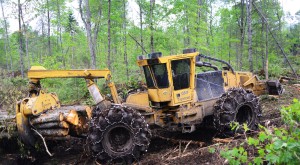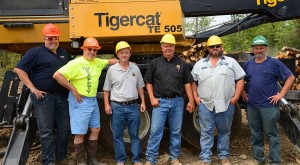J.D. Irving, Limited is a large, privately owned Canadian company headquartered in Saint John, New Brunswick. Founded in 1882, the company has operations throughout eastern Canada and Maine. Its diverse business sectors include forest products, transportation, ship building, industrial equipment, construction services and consumer products.
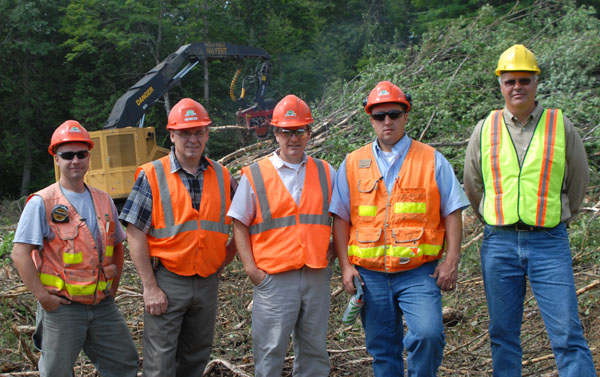
(L-R) Matt Collins, process improvement; Peter Tabor, regional manager; Josh Philbrook, operations superintendent; Dana Johnston, process improvement; Keith Michaud, sales representative for Tigercat dealer in Maine, Frank Martin Sons Inc.
Founder, James Dergavel Irving developed a sawmill, gristmill and carding mill among other enterprises. Another key family member was J.D.’s son, Kenneth Colin who diversified into the transportation, ship building, construction and retail sectors. Grandson, James K. pioneered the company’s reforestation and tree improvement programs and expanded the forest products business.
The forestry and forest products business is now 130 years old and remains firmly focused on the future. “Renewing the forest is a promise we have been keeping since 1957 with over 877 million trees planted to date. If we are careful stewards of this resource, we will start to generate a return on our investment in less than 50 years. That’s a long cycle, but it illustrates how profoundly our business embodies the principles and practices of corporate sustainability,” says Jim Irving, Co-CEO of the company. This focus on long term planning sustains an integrated value chain of environmentally certified forest products.
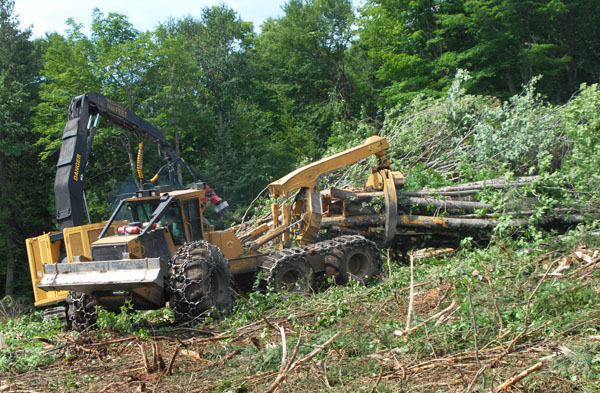
A 630D or 635D skidder hauls to the processor. The machines are equipped with GIS technology which maps the felling corridors and helps the skidders to maintain a steady flow of wood to the processor.
Irving Woodlands has been working in Aroostook County, Maine for 65 years, directly employing 255 with wages that are more than 60% higher than the state average. The company also generates an additional 687 jobs through 155 woodlands contractors. The forest land base provides a sustainable wood supply to twenty mills in the state.
“We work hard to provide competitive earnings and the opportunity to significantly increase those earnings, pioneering the use of best-in-class technology and work practices,” explains Peter Tabor, regional manager for Maine.
About 20% of Irving’s Maine land base is dedicated to habitat conservation. Forest research and conservation is a primary focus in the company’s forestry activities. “We also have contributed over $1 million to forest research at the University of Maine to help keep Maine’s forestlands healthy, productive and sustainable,” says Peter.
Irving Woodlands — along with nineteen other landowners and several wood processing and corporate members – is a member of the Cooperative Forest Research Unit (CFRU) at the University of Maine in Orono. Areas of research pursued in the past few years include assessing the risk and impact of future spruce budworm outbreaks in Maine forests and strategies for improving hardwood regeneration, among many other topics addressing important forest sustainability issues in the state.
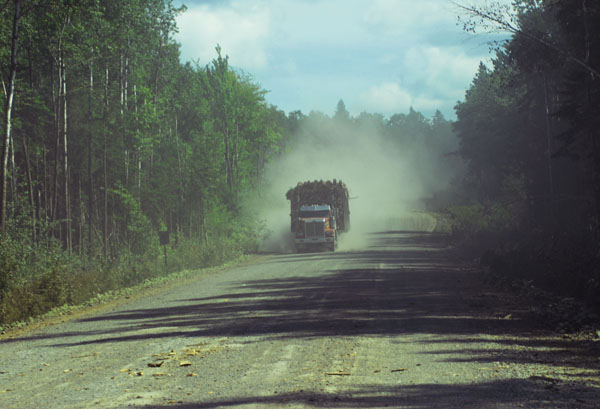
Wide, straight roads are an Irving hallmark and large payload off-highway transport is key to reducing fibre costs.
The company’s forest practices are audited by independent experts in accordance with principles of the Forest Stewardship Council (FSC) and the Sustainable Forestry Initiative (SFI). “Certification is about accountability. Don’t take our word for it, consider the rigorous independent review by the experts to ensure that forestlands are promptly regenerated and measures are taken to protect water quality, wildlife habitat and species at risk,” says Peter.
Irving’s silviculture program includes a nursery which produces 25 million trees per year and an extensive stock and seedling research division. The company has recently discovered a naturally occurring spore in spruce trees that makes them more resistant to spruce budworm. A patent is pending for this innovation.
Irving’s total annual harvest in Maine is one million tons “in a region where wood costs are not low,” explains Peter. This is where things get interesting. In order to compete against low cost offshore hardwood chips, Irving has placed an incredible focus on cost saving efficiencies across every function and level of its forestry operations without sacrificing the integrity of the land and forests or the quality of the product.
Key to the entire woodlands operation is cost effective transportation. Irving invested in a chip handling yard with rail spurs in 2006 that connects its woodlands to the mill in Saint John, New Brunswick. A daunting 320 km (200 mi) jaunt on the highway, Peter explains that “rail brings you a hundred miles closer.”
In combination with the rail siding in Ashland, Irving makes extensive use of off-highway truck transport, using the intricate network of legacy and newly constructed forest roads to move fibre from the harvesting sites to the Ashland yard without travelling over a single paved kilometre. Hardwood logs, long length softwood pulp and chips all come into the yard on off highway trucks and ship out by rail. Operations superintendent, Josh Philbrook, says that the greater payloads made possible with off-highway transport represent a 20% savings over regular highway trucking. Specially designed chip vans carry 60 ton loads (1 ton equals approximately 900 kg). To take full advantage, Irving constructed a special chip dumper in 2006 that can lift truck and trailer, reducing the unload time by fifteen minutes because the trailer does not have to be detached.
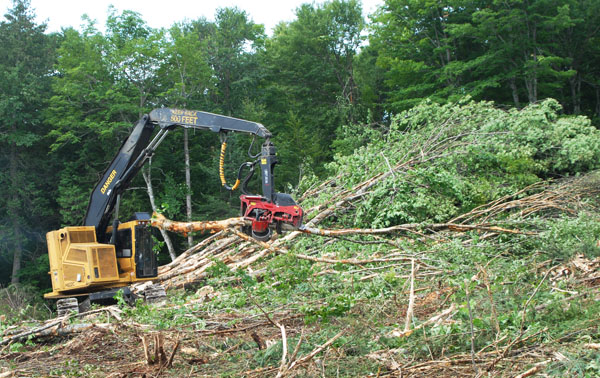
The H822C merchandizes high value logs, prepares trees for the chipper and sorts maple and mixed hardwood in indexed piles.
In a bid to further whittle away at transportation costs, Irving builds or rebuilds 160 km (100 mi) of forest road annually. “An Irving trademark is high quality, straight roads — for safety and efficiency,” Josh asserts. The focus is on wide, straight roads with as much visibility as possible to increase the average speed of the hauling trucks.
Irving sets up, finances and trains owner-operator contractors, the majority of which own a single machine rather than a whole system. Contractors work together and the typical system combines a feller buncher and skidder for initial extraction. Irving is partial to 822C feller bunchers for the mostly selective cut operations. The skidder — either a 630D or 635D depending on optimal drag size, skid distance and required flotation — pulls to a box at roadside where an H822C harvester processes and sorts softwood, mixed hardwood and maple, cutting saw logs and valuable veneer logs before “prepping” the hardwood pulp by busting up (but not removing) the limbs so that the trees can be fed into and digested by the chipper more easily.
The high-value hardwood logs are short hauled by the skidder and decked closest to the road and the softwood is swung around behind the harvester toward the road. Once the processor is finished, and the logs and softwood have been hauled away, a 630D skidder and a chipper come in. What remains are two or three extended decks of tree-length or near tree-length hardwood pulp. The maple is on top and indexed about three metres behind and underneath is the mixed hardwood sort. “The skidder can pull off the top to the chipper without disturbing the sort underneath,” explains Josh.
These sorting, merchandising and chipper preparation functions used to be accomplished with stroke delimbers and slashers. The H822C harvesters equipped with Waratah heads are more efficient — doing a better job of sorting and indexing, achieving better utilization by cutting more high value logs – all while eliminating a machine.
To help the skidder balance distances, optimize for day and night shifts and keep the processor well fed, Irving has developed its own in-house GIS system. At the end of each shift, all the data related to the cutting activity of the feller buncher is downloaded to the skidder. Through the in-cab interface, the skidder operator at a glance can see the feller buncher trails and related distances and topography. “He can look at the whole block and understand it to be more efficient,” comments Peter.
Another area of focus is data collection. Irving goes beyond tracking machine productivity and input costs. Machine downtime is carefully broken down and categorized. When a machine is idle — even for a short period of time — the operator must input one of ten stop codes. Analyzing this data is very beneficial in determining which way to tweak best practices to create the most balance and throughput.
Placing great emphasis on continuous improvement, Irving has Sigma-6 trained employees like Dana Johnston on staff completely focused on process improvement initiatives. Dana explains that they have worked out hourly productivity requirements for the skidder by analyzing the twitch size, distance and drive speed achievable for a given block. “The day shift operator might mix and match — bring three short skids in and then go for a long one,” says Dana. Generally the night shift operators will stick to the longer trails where they can be more efficient. The skidder operators will also try to equalize skid distances and times by pulling outlying twitches to the closest corner of the block and short distance twitches to the further corners.
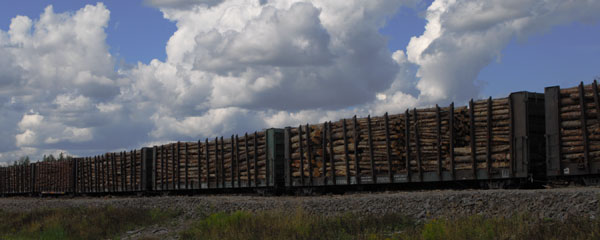
With a rail siding at the Ashland yard, the Maine operations make extensive use of rail for transporting chips and round wood.
The skidders target six ton twitches but the payload can drop as low as 3.5 tons. The operators must strike a balance between the load size and the time it takes the skidder to acquire the load. The number of sorts and the volume and density of the block can significantly constrain payload. “If the skidder has to stop four times, it might be better to bring in smaller twitches or have the buncher sort or build bigger bunches, knowing it is going to affect these guys downstream,” comments Peter.
The chipping sides work two twelve-hour shifts, five days per week, producing an average of 3,000 tons per week. Irving made the transition to in-field chipping in 2006. Previously, pulpwood was processed in random lengths and transported as round wood. In-field chipping results in 15% more chip volume right off the top because the large branches and tops get chipped as well. Higher recovery rates are not the only advantage. The process is also less expensive. The downside? Slightly higher bark content and two percent oversize chips which are screened out further downstream. But as Peter says, “We are integrated, so we can make it work.”
In-field chipping has other advantages — especially to a company as vertically integrated as Irving. The more processing that can be done close to the stump, the better, according to Josh and Peter, because this ultimately decreases handling and transportation costs downstream and ensures that each product gets to the right market or mill by the most direct routing.
All of Irving’s land in Maine is designated open use and available to the public for recreation opportunities. In these matters, Irving is represented by North Maine Woods, an organization that administers recreation land for private landowners. It has over 1,4 million ha (3.5 million acres) under its umbrella and represents landowners varying from large corporations like Irving to individuals and families with relatively small parcels. Although the land ownership structure is a patchwork, recreational users are guided by just one set of uniform regulations and fees and do not have to obtain several permits or pay different user fees to different landowners.
After touring the operations for a day, it is glaringly apparent how much the company and employees care about the forestland. Peter and Josh are constantly questioning and discussing the way things are currently done and discussing how various aspects of the operations could be improved – whether the improvements are related to production, safety, forest health or aesthetics. An obvious sense of pride and long term thinking prevails. “We are proud to live, work and raise our families in Maine,” says Peter. “Our everyday work in the woods is about sustainability — for the community, the environment and for the economy.”
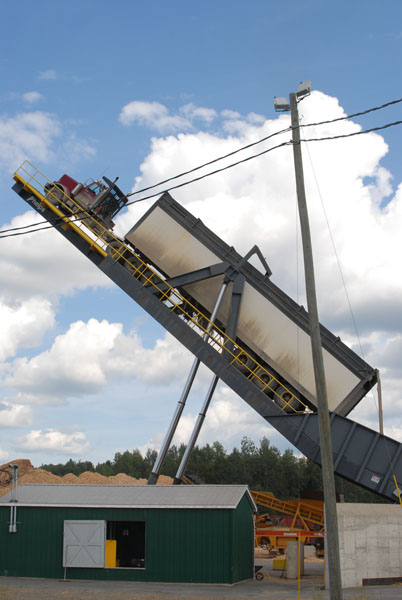
Irving constructed a special chip dumper that can lift truck and trailer, reducing unload times.








